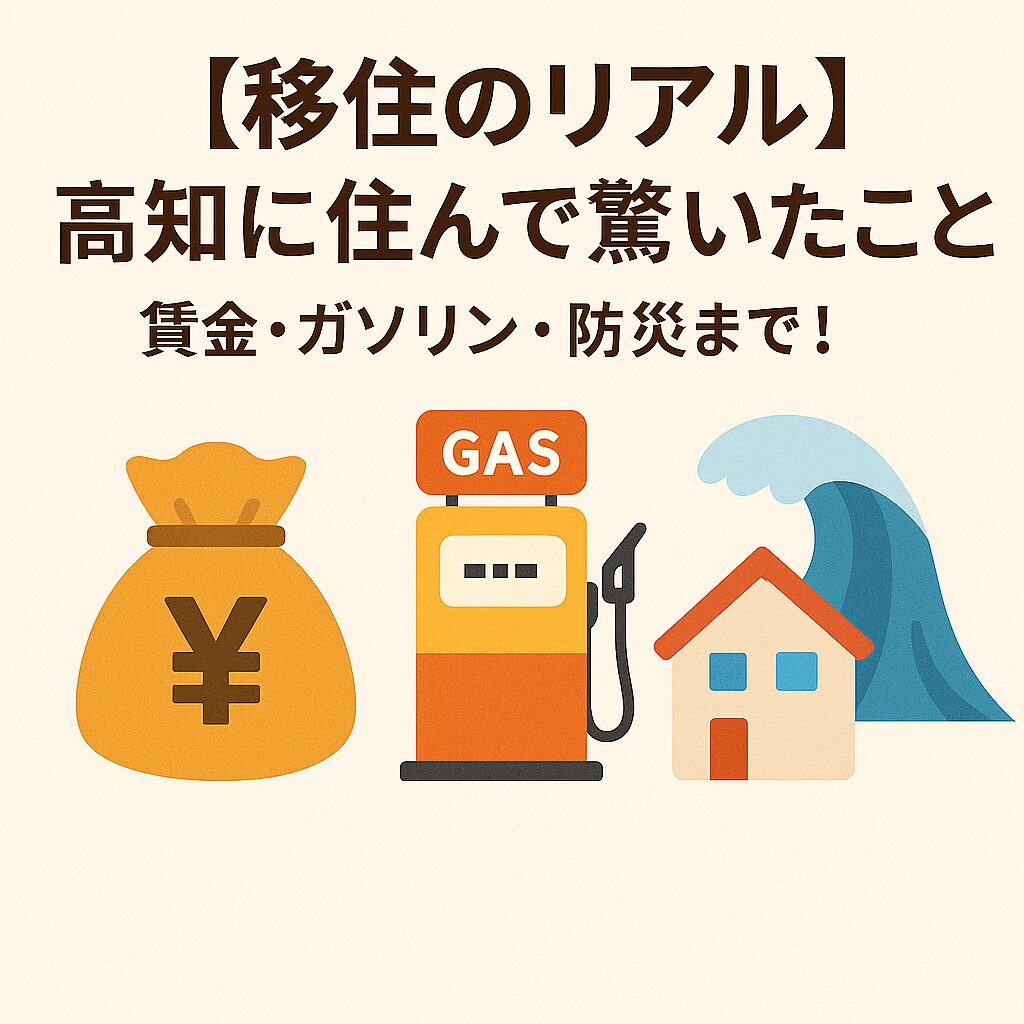Following up on my previous post
🏡 🏡 [Life in Kochi] 3 Things That Surprised Me After Moving Here – Housing, Transportation, and TV Life! Part 1 | SacChi’s Love Affair with Kochi
this article dives into the question:
“Is Kochi actually a livable place?”
“How do salaries and living costs compare?”
Here’s Part 2 of my honest reflections, based on personal experience.
If you’re interested in regional relocation, U-turn moves, or local policy, read on!
💼 ① Kochi’s Wages Are Among the Lowest in Japan
Here are the average monthly wages by prefecture for 2024 (official employment):
| Prefecture | Average Wage (¥1,000s) | Rank |
|---|---|---|
| Tokyo | 403.7 | 1st |
| Osaka | 348.0 | 3rd |
| Kochi | 273.3 | 40th |
| National Average | 330.4 | – |
Source: Ministry of Health, Labour and Welfare, 2024 Basic Survey on Wage Structure
Additionally, Kochi’s minimum hourly wage in 2024–2025 is set at ¥952, placing it 42nd nationwide, on par with Iwate, Kumamoto, Miyazaki, and Okinawa.
📌 Because income levels are lower than in urban areas, those considering a move should:
- Find roles that leverage specialized skills or national certifications
- Maintain urban-level income via remote work
- Consult Kochi’s UI Turn Support Center for tailored job and relocation assistance
Despite the low wages, living costs are relatively affordable, and you can often find fresh produce at low prices—or even for free—at local “honesty markets” (ryōshin-ichi). This is one of Kochi’s underrated perks! 🍅
⛽ ② Gas Prices Can Be Shockingly High
As of July 2025, the average price of regular gasoline in Kochi is ¥174.2 per liter (29th nationally). While prices have cooled recently, Kochi had the highest price in Japan back in January 2025 at ¥194/L.
- Most gas stations in the prefecture have the same price—no real savings between self-serve and full-service
- Pro tip: When driving outside of Kochi, refuel after crossing the prefectural border to save money!
🚗 As I mentioned in Part 1, Kochi is a car-dependent region. Planning your fueling strategy and choosing a fuel-efficient vehicle can make a big difference in your household budget.
🧭 ③ Kochi Leads Japan in Disaster Preparedness
Given the ever-present risk of the Nankai Trough Earthquake, Kochi Prefecture is proactive in disaster education and community preparedness.
Along the coast, tsunami evacuation towers are installed in many areas. Earthquake drills are held not only in schools but also throughout local communities.
✅ Disaster Education in Schools
Kochi has developed its own safety education programs that cover:
- Earthquakes, tsunamis, severe weather, traffic safety, and general daily safety
- Age-appropriate materials like the “Disaster BOOK” for young learners
In Kochi City’s model, schools, families, and neighborhoods work together to conduct coordinated evacuation drills.
This approach has even been featured in the Ministry of Education’s national case study collection, attracting attention across Japan.
✅ 2024 Disaster Awareness Survey (Kochi Prefecture)
| Topic | Implementation / Awareness Rate |
|---|---|
| Tsunami evacuation awareness | 68.0% |
| 3+ days of food stockpiling | 33.3% |
| 3+ days of water stockpiling | 37.5% |
| Furniture anchoring | 28.5% |
| Awareness of support programs for furniture anchoring | 35.4% |
| Participation in disaster drills (workplace/community) | 36.0% |
| Awareness of emergency Nankai Trough alerts | 54.4% |
| Willingness to evacuate when alert is issued | 72.4% |
Kochi also ranks #1 nationwide for BCP (Business Continuity Plan) implementation among companies, at 33.3%.
🧯 In short: Be prepared, not scared.
✍ Summary – In Kochi, Knowledge & Strategy Are Key to Relocation
- Wages are among the lowest in Japan, so career strategy matters
- High gas prices are a reality in this car-centric society—plan accordingly
- Disaster education is top-tier, giving you peace of mind through local support
If you’re thinking about moving to Kochi, I hope this honest breakdown helps you navigate both the pros and the quirks of local life.
👉 Stay tuned for future posts in the “Real Life in Kochi” series!



コメント